Winter jacket field-gray feldgrau parka Elite 5-point pockets 1942-45
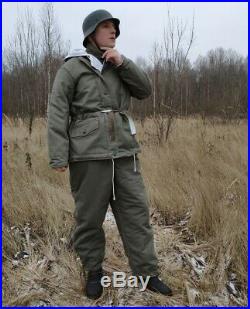
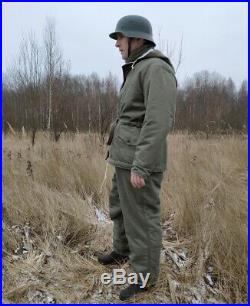
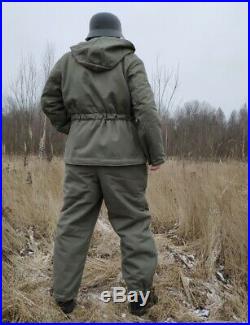
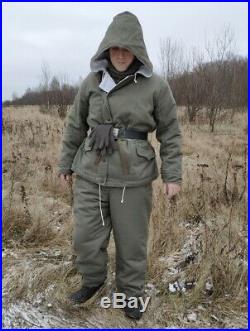
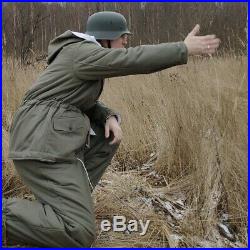
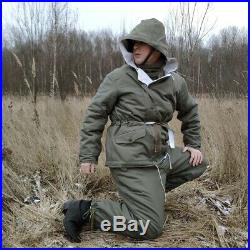


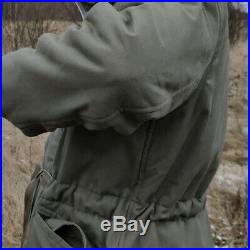
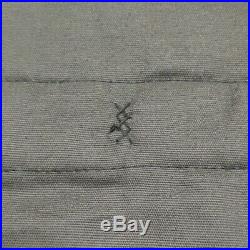


Neither pants nor helmet, belt are included (despite the fact that they are shown in the photo). We offer matching pants in another listing.
The parka is sewn from dense natural fabric with with plain weave (such as a tent or cotton duck). Such fabric protects best from wind and water. The fabric does not get wet slowly, but is not completely waterproof, of course. The fabric is dense but not rigid.
Pants match the color of a similar jacket (see related products at the bottom of the page). The shade of the fabric may be slightly different on a new batch in a year! This is a responsible copy from a German sample.
The patterns were developed from scratch under the control of the our shop. The pants are sewn by professionals on a factory, using heavy sewing equipment. The jacket has an additional valve that protects the clasp from the wind; it fastens in the opposite direction relative to the front clasp.
Its use is not necessary, it can be fastened and hidden under the front clasp. The jacket is pulled over the waist with double-sided tape. The waist of the jacket is very wide, suitable for any body-shape. The insulation from recycled clothing is used inside, as it was in the originals. The Germans collected the old uniforms, as well as civilian clothes (including trophy and confiscated) and recycled it, getting a cloth like a loose blanket.The composition of such insulation varied due to the heterogeneity of the raw materials. In general, winter suits were not very warm. They had to be worn over a shirt, a cloth uniform and a sweater (a multilayer military uniform system is used to date). In a full suit, it is comfortable down to -15 degrees Celsius, however, this is not enough for guard duty (long inactivity), for this there were a special overcoat and guard boots. We were attentive to the details, found and copied even insignificant and inconspicuous at first glance.
Button loops have a round end (eyelet) and a perpendicular limiting seam (lock) at the other end. This jacket has grained buttons on both sides, Feldgrau (gray-green) colour on "autumn" side and white on "winter". The first winter suits had metal grain buttons (standard for the German uniform).
We reproduced this: there are grained buttons from the "autumn" and "winter" sides on our 1942 suits. They are painted, respectively, in a field gray (dull green, Feldgrau) and white. Buttons for colored ribbons are sewn on the sleeves above the elbow. These tapes had a conventional bright color (usually red or green) and allowed to distinguish their own from strangers on a monotonous snowy background. This system was no longer used at the end of the war, so buttons on camouflage models are rare after 1943.There are no patches on the knees on this model, because the first 1942 model did not have them. There is also no counter-flap (wind-valve) on the front. These details appeared later in 1943. Access to the pockets is possible both from the "autumn" and from the "winter" side: there is a partition at the entrance so that the hand does not pass through, but falls down into the pocket.
The pocket valves are 5-point, as it was in the Elite only. We have sizes I, II and III at the moment (all sizes).Please write your size in the order or message after the order. How to care for the product? The soldiers at the front did not have the opportunity to wash their jackets (especially in the washing machine).
After the winter (or in the case of taking the unit to rest in the deep rear), they handed the winter uniform over, and the rear services cleaned, sorted and stored it. Therefore, washing the winter uniform in the washing machine is an extreme measure.
To get started, you just need to wash the jacket with a sponge or a soft brush with soap or detergent for natural fabrics in those places where it is dirty (usually this is the neck and cuffs). You can wash off the detergent with a jet of water (shower in the bathroom, for example). The use of bleach (stain remover) is permissible only manually on the white side and on a dry jacket. So you can return the whiteness to the cuffs and other dirty areas. However, if bleach seeps onto the camouflage side (for example, through a seam), white spots will forever remain.
It is unacceptable to wash the entire jacket in bleach! Washing a jacket is the removal of contaminants from external surfaces; inside the jacket there is nothing to wash. If you decide to save time and wash in a machine, then select the delicate washing mode at a temperature of no higher than 40 degrees. The jacket will not deteriorate, the color will not fade, however, the jacket will slightly lose its shape and will no longer look like new. It needs only 1-2 weeks to get any point on the globe for almost the same price! The item "Winter jacket field-gray feldgrau parka Elite 5-point pockets 1942-45" is in sale since Thursday, February 20, 2020. This item is in the category "Collectibles\Militaria\WW II (1939-45)\Reproductions\Germany".ru" and is located in Moscow. This item can be shipped worldwide.- Season: Winter
- Modified Item: No
- Country/Region of Manufacture: Russian Federation
- Type: Uniform
- Colour: Camouflage